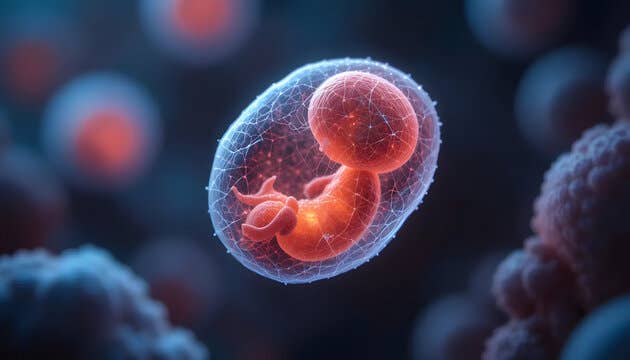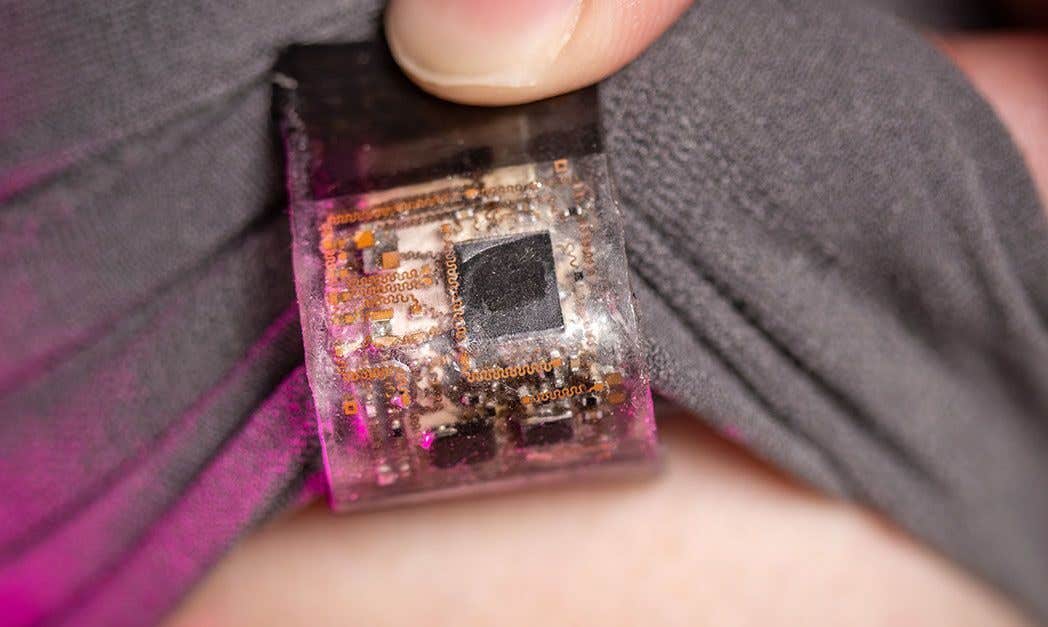Ancient DNA is still shaping early embryo development in humans and other mammals
Study found that ancient viral sequences hidden in DNA, long thought to be extinct, come back to life during early development.

Ancient viral DNA long thought extinct is active during early embryo growth, steering gene expression and shaping development across mammals. (CREDIT: Adobe Stock)
In the earliest hours after fertilization, an embryo takes its first steps toward becoming a living organism by shedding maternal control and activating its own genetic program. This critical process, called embryonic genome activation (EGA), flips a biological switch that lets the embryo start producing RNA from its own DNA rather than depending on genetic material from the egg. But what exactly flips that switch—and how it works across different mammals—has remained a mystery.
A new study by researchers at Helmholtz Munich and Ludwig-Maximilians-Universität (LMU) changes that. By examining embryos from several mammals, the team discovered that ancient viral sequences hidden in DNA, long thought to be extinct, come back to life during early development. These sequences, called transposable elements, or TEs, are not just passive junk. They help shape the very foundation of how embryos grow.
Ancient Viral DNA Wakes Up in the Embryo
Transposable elements are fragments of viral DNA that infected our ancestors millions of years ago. Over time, they became embedded in our genomes and passed down through generations. Today, they make up more than half of the human and mouse genomes. Scientists used to think they were dead code—leftovers without a purpose. But this study shows they’re far from inactive. In fact, many TEs get reactivated right when the embryo begins to develop on its own.
Using a new method called Smart-seq+5′, the research team tracked how these sequences behave in embryos from five species: mouse, rabbit, cow, pig, and rhesus macaque. This technique allowed scientists to capture the full length and starting point of RNA transcripts at the single-cell level. The method builds on earlier RNA sequencing approaches but adds more precision by revealing exactly where transcription begins.
This detailed look revealed that 19,657 gene transcripts across species were driven by TEs. That means thousands of genes may be turned on by ancient viral elements in early development. These transcripts didn’t just appear randomly. They followed both shared patterns across species and species-specific ones, suggesting some parts of early development are deeply conserved across evolution, while others have evolved unique traits.
A Surprising Role in Cell Identity and Fate
The fact that TEs are not only active, but also play a direct role in gene regulation, is turning old ideas upside down. They carry regulatory sequences—tiny bits of code that attract transcription factors and other proteins needed to start gene activity. In early embryos, where thousands of genes need to be activated at once, this built-in ability to recruit the right molecules makes TEs powerful players.
Related Stories
“We’ve shown that transposable element activation is a distinctive feature of early embryos in several mammalian species,” said Prof. Maria-Elena Torres-Padilla, who led the study. “These early-stage cells can become any type of body cell, and by understanding how they control these ancient viral elements, we get important clues about how cellular plasticity works.”
Plasticity refers to a cell’s ability to become many different types of cells. That’s why stem cells, especially those in early embryos, are so valuable for research and medicine.
This study suggests that TEs may help regulate this flexibility by turning on or off key genetic pathways during the narrow window when cell fate is still being decided.
Co-first author Dr. Marlies Oomen added, “This approach gives us a new way to influence cell fate, like guiding stem cells to become specific tissues. Instead of targeting hundreds of genes, we can now consider targeting the transposable elements that regulate them.”
Unlocking Shared Genetic Patterns Across Mammals
By looking at species that are evolutionarily distant—such as pigs and monkeys—the study captured how TE activity behaves across the tree of life. Some TE families showed similar activity across all five species, while others varied greatly. This mixture of conservation and divergence helps scientists understand which parts of early development are essential and which have evolved more recently.
Certain types of TEs, such as LINEs and ERVL elements, are known to be active in early mouse and human embryos. For instance, mouse mERVL and its human cousin hERVL show similar behavior during EGA. These elements not only get reactivated but also influence chromatin structure—the way DNA is packaged inside cells. By opening up tightly packed regions of DNA, TEs allow the machinery of transcription to reach the genes that need to be turned on.
What makes this discovery more powerful is the ability to identify the exact start sites of transcripts. Older methods of RNA sequencing often couldn’t tell whether a TE was responsible for starting transcription or just sitting nearby when it happened. Smart-seq+5′ fixed that problem by using a tagmentation strategy to map transcription start sites more accurately.
A Game-Changing Resource for Reproductive Biology
While many previous studies have focused on model species like mice or humans, this study’s cross-species approach breaks new ground. By comparing 34 different developmental stages across five mammals, the team created a single-cell atlas of early embryonic gene activity that scientists can now explore in depth.
“This dataset is the first of its kind,” said Prof. Torres-Padilla. “It gives us a way to look at how early development works not just in one species, but across evolution.”
For developmental and reproductive biologists, this resource could be transformative. It allows researchers to study how gene expression changes at key stages of development and how those changes are controlled. It could also lead to breakthroughs in reproductive medicine, where understanding why embryos fail to develop properly is a major challenge.
The findings offer more than just basic science. They open new doors for manipulating genes in early development. Instead of editing individual genes one by one, scientists might one day harness TEs to turn whole gene networks on or off. This would speed up efforts to grow tissues from stem cells or treat diseases that begin in early development.
Reviving the So-Called "Junk DNA"
What was once thought of as genomic noise now seems to be a key player in life's first steps. The discovery that transposable elements wake up during EGA, drive gene expression, and shape how cells decide their fate, flips the script on what makes our genome tick.
The activation of these ancient sequences appears not to be a random side effect of chromatin remodeling. Instead, it looks like evolution has kept these elements around because they serve a purpose—especially during one of the most critical phases of life.
With this new understanding, the next chapter of genetics may focus not just on genes themselves but also on the vast and mysterious stretches of DNA that surround them. Transposable elements are no longer the dark matter of the genome. They are a functional part of life’s blueprint—and may hold the keys to unlocking the secrets of development, disease, and regeneration.
Research findings are available online in the journal Cell Press.
Note: The article above provided above by The Brighter Side of News.
Like these kind of feel good stories? Get The Brighter Side of News' newsletter.



